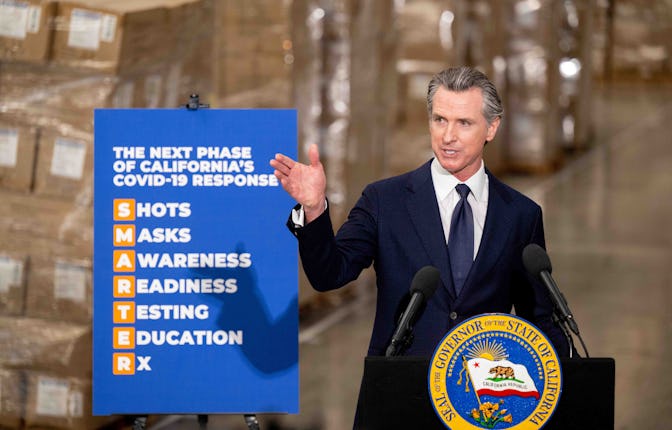This what "endemic" COVID could look like
Inside California's new plan to transition out of the pandemic.

This week, California Governor and hair gel enthusiast Gavin Newsom revealed plans to propel his state into the next phase of COVID recovery. His new approach would involve shifting his state’s perspective on COVID to achieve a semblance of normalcy and encourage people to learn to live with the virus, as opposed to letting the virus dictate every aspect of our existence, per CNN.
So far, the world has been treating COVID as a pandemic because the virus has been unpredictable, deadly and widespread. Newsom’s ‘SMARTER’ plan — which stands for Shots, Masks, Awareness, Readiness, Testing, Education and Rx — aims to change his previous pandemic approach into an endemic one.
In contrast, an endemic is when a virus or disease is “present at a fairly stable, predictable rate among a group of people,” per the JAMA Network. For example, the flu and common colds are endemic threats that we expect to see every year, but they don’t dictate how we organize our lives.
In a press conference on Thursday, Newsom argued that we know much more about the virus now than we did two years ago when we went into lockdowns and that there will be no “end date” to COVID. Rather than assuming that everyone is at equally high risk of COVID, the new approach would include lots of testing and containing outbreaks at a local level, per Forbes.
California’s approach could serve as a template for the rest of the country as pandemic fatigue pushes Democratic-led states to relax mask mandates and other restrictions. A likely outcome as we enter the third year of the pandemic is that COVID spikes won’t lead to the sort of large-scale shutdowns they have in the past. Instead, outbreaks could be dealt on a case-by-case basis and mask-wearing would be enforced only in high-risk communities. Those who are unvaccinated may also experience a different set of restrictions during COVID spikes, since they will be at a generally higher risk than the rest of the vaccinated population.
If all goes according to plan and the rest of the country follows California’s lead, this might be the year that things actually start to feel a little bit more like they did pre-2020, assuming that another super variant doesn’t ruin things for all of us again. I, for one, am still going to keep wearing masks in public transportation and grocery stores, mostly out of extra caution and habit. But I’m also ecstatic to stop organizing my life around the whims of the ‘rona.